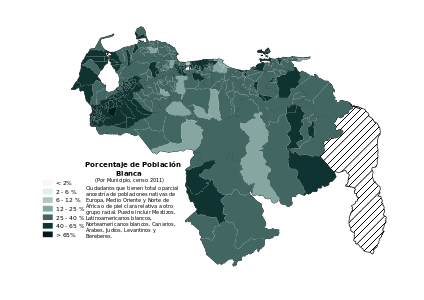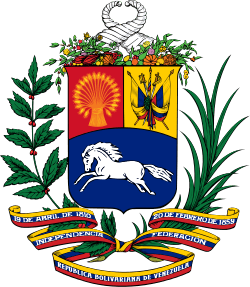Demographics of Venezuela
The Demographics of Venezuela are the condition and overview of Venezuela's peoples. Demographic topics include basic education, health, and population statistics as well as identified racial and religious affiliations.
Overview
The Venezuelan people comprise a combination of heritages. The historically present Amerindians, Spanish colonists, and African slaves have all contributed to varying degrees. Later, waves of European groups (Italians, Portuguese and Germans) migrated to Venezuela in the 20th century, influencing many aspects of Venezuelan life, including its culture, language, food, and music.
About 51.6% of the population is Mestizo, while 43.6% are full white of European ancestry and/or Middle Eastern ancestry. Another 3.7% is black/African, while 2.7% is of full Amerindian ancestry, and 1.0% other races ( principally Asian people).[1][2]
Three Amerindian tribes located in the country are the Wayuu, located in the west, in Zulia State, and the Timoto-cuicas, also in the west, in Mérida State, in the Andes.
About 85% of the population live in urban areas in the northern portion of the country and currently resides in the urban conglomerations (Caracas, Maracay, Maracaibo, Valencia, etc.) that are concentrated in Venezuela's northern coastal mountain strip. Nearly half of Venezuela's geographic area lies south of the Orinoco River; however, this region contains only 5% of the Venezuelan population.
The World Factbook 2011 estimate puts Venezuela's total population at 27,635,743 inhabitants.[3] Additionally, over the past five years, Venezuelan society's general age structure has been trending towards the homologous structure found in Cuba, Western Europe, Japan, and other healthy and rapidly aging societies. Notably, there has been a significant increase in the proportion and gross numbers of elderly Venezuelans (aged 65 and up), as well as a corresponding drop in the total fertility.
Population
| Census population | ||
|---|---|---|
| Year | Pop. | ±% p.a. |
| 1873 | 1,732,411 | — |
| 1881 | 2,005,139 | +1.84% |
| 1891 | 2,221,572 | +1.03% |
| 1920 | 2,479,525 | +0.38% |
| 1926 | 2,814,131 | +2.13% |
| 1936 | 3,364,347 | +1.80% |
| 1941 | 3,850,771 | +2.74% |
| 1950 | 5,034,838 | +3.02% |
| 1961 | 7,523,999 | +3.72% |
| 1971 | 10,721,522 | +3.61% |
| 1981 | 14,516,735 | +3.08% |
| 1990 | 18,105,265 | +2.48% |
| 2001 | 23,232,553 | +2.29% |
| 2011 | 27,227,930 | +1.60% |
According to the 2010 revison of the World Population Prospects the total population was 28,980,000 in 2010, compared to only 5,094,000 in 1950. The proportion of children below the age of 15 in 2010 was 29.5%, 64.9% was between 15 and 65 years of age, while 5.6% was 65 years or older .[4]
| Total population (x 1000) |
Proportion aged 0–14 (%) |
Proportion aged 15–64 (%) |
Proportion aged 65+ (%) | |
|---|---|---|---|---|
| 1950 | 5 094 | 43.5 | 54.6 | 1.9 |
| 1955 | 6 221 | 44.8 | 53.1 | 2.0 |
| 1960 | 7 562 | 45.6 | 51.9 | 2.4 |
| 1965 | 9 067 | 46.4 | 51.0 | 2.6 |
| 1970 | 10 681 | 45.7 | 51.5 | 2.8 |
| 1975 | 12 681 | 43.3 | 53.6 | 3.0 |
| 1980 | 15 036 | 40.7 | 56.2 | 3.2 |
| 1985 | 17 269 | 39.0 | 57.6 | 3.4 |
| 1990 | 19 685 | 38.0 | 58.3 | 3.7 |
| 1995 | 22 035 | 36.0 | 59.9 | 4.1 |
| 2000 | 24 348 | 33.7 | 61.7 | 4.5 |
| 2005 | 26 664 | 31.3 | 63.7 | 5.0 |
| 2010 | 28 980 | 29.5 | 64.9 | 5.6 |
Vital statistics
Registration of vital events is in Venezuela not complete. The Population Departement of the United Nations prepared the following estimates. [4]
| Period | Live births per year |
Deaths per year |
Natural change per year |
CBR* | CDR* | NC* | TFR* | IMR* | Life expectancy total |
Life expectancy males |
Life expectancy females |
|---|---|---|---|---|---|---|---|---|---|---|---|
| 1950-1955 | 263 000 | 69 000 | 193 000 | 46.5 | 12.6 | 34.1 | 6.46 | 107 | 54.3 | 52.9 | 55.8 |
| 1955-1960 | 309 000 | 73 000 | 236 000 | 44.9 | 10.9 | 34.2 | 6.46 | 89 | 57.1 | 55.6 | 58.7 |
| 1960-1965 | 375 000 | 77 000 | 298 000 | 45.1 | 9.5 | 35.7 | 6.66 | 73 | 59.9 | 58.2 | 61.7 |
| 1965-1970 | 397 000 | 76 000 | 320 000 | 40.1 | 8.0 | 32.4 | 5.90 | 60 | 62.6 | 60.5 | 64.9 |
| 1970-1975 | 411 000 | 76 000 | 334 000 | 35.1 | 6.7 | 28.6 | 4.94 | 49 | 65.0 | 62.4 | 67.7 |
| 1975-1980 | 476 000 | 81 000 | 395 000 | 34.2 | 5.8 | 28.4 | 4.47 | 39 | 67.3 | 64.6 | 70.4 |
| 1980-1985 | 519 000 | 89 000 | 430 000 | 32.0 | 5.3 | 26.5 | 3.96 | 34 | 68.9 | 66.0 | 72.0 |
| 1985-1990 | 561 000 | 92 000 | 468 000 | 30.3 | 4.9 | 25.3 | 3.65 | 27 | 70.5 | 67.7 | 73.5 |
| 1990-1995 | 563 000 | 101 000 | 461 000 | 26.9 | 4.8 | 22.1 | 3.25 | 23 | 71.5 | 68.7 | 74.5 |
| 1995-2000 | 569 000 | 114 000 | 455 000 | 24.5 | 4.9 | 19.7 | 2.94 | 21 | 72.1 | 69.3 | 75.1 |
| 2000-2005 | 585 000 | 129 000 | 456 000 | 22.9 | 5.0 | 17.9 | 2.72 | 19 | 72.7 | 69.9 | 75.8 |
| 2005-2010 | 598 000 | 142 000 | 456 000 | 21.4 | 5.1 | 16.3 | 2.55 | 17 | 73.7 | 70.8 | 76.8 |
| 2010-2015 | 601 000 | 159 000 | 442 000 | 19.9 | 5.3 | 14.6 | 2.40 | 15 | 74.5 | 71.7 | 77.6 |
| 2015-2020 | 595 000 | 178 000 | 417 000 | 18.4 | 5.5 | 12.9 | 2.28 | 13 | 75.3 | 72.5 | 78.4 |
| * CBR = crude birth rate (per 1000); CDR = crude death rate (per 1000); NC = natural change (per 1000); IMR = infant mortality rate per 1000 births; TFR = total fertility rate (number of children per woman) | |||||||||||
CIA World Factbook demographic statistics
The following demographic statistics are from the CIA World Factbook, unless otherwise indicated.
Total population
- It has a population of 31,292,000 as of 2014.
Population growth rate
- 1.508% (2009 estimate).
Sex ratio
| Age | Ratio (males/females) |
|---|---|
| Total: | 1.02 |
| At birth: | 1.07 |
| Under 15: | 1.07 |
| 15-64: | 1.01 |
| Over 65: | 0.83 |
Literacy and education
The accepted formal and demographic definition of the literacy rate is that proportion or percentage of the Venezuelan population older than age 15 that can both read and write. The below are 2006 estimates from the INE.
| Population group | % |
|---|---|
| Total population: | 95.1% |
| Male: | 95.4% |
| Female: | 94.8% |
Ethnicity
According to an autosomal DNA genetic study conducted in 2008 by the University of Brasilia (UNB) the composition of Venezuela's population is: 60.60% of European contribution, 23% of Amerindian contribution and 16,30% of African contribution.[5]
-

Map of proportion in percentage of the mestizo population in Venezuela by Municipalities. Data from the 2011 Census.
-

Map of proportion in percentage of the white population in Venezuela by Municipalities. Data from the 2011 Census.
-

Map of proportion in percentage of the black and afro-descendant population in Venezuela by Municipalities. Data from the 2011 Census.
-

Concentration of the mestizo population, expressed in persons per square kilometers. Data from the 2011 Census.
-

Concentration of the white population, expressed in persons per square kilometers. Data from the 2011 Census.
-

Concentration of the black and afro-descendant population, expressed in persons per square kilometers. Data from the 2011 Census.
Religious affiliation
The overwhelming majority of Venezuelans denote themselves as adherents of Catholicism; this is true nominally if not in practice.
| Religion | % |
|---|---|
| Roman Catholic: | 96% |
| Protestant: | 2% |
| Others: | 2% |
Alternatively, according to government estimates, 92% of the population is at least nominally Roman Catholic, and the remaining 8% are Protestant, a member of another religion, or non-religious. The Venezuelan Evangelical Council estimates that Evangelical Protestants constitute 10% of the population.[6]
References
 This article incorporates public domain material from websites or documents of the CIA World Factbook.
This article incorporates public domain material from websites or documents of the CIA World Factbook.- Acosta, Maruja. "Urbanizacion y clases sociales en Venezuela." Revista Interamericana de Planificacion Bogota, 7, No. 26, June 1973, 22-44.
- The article contains a statistical reference from the Wikipedia public domain Mestizos (2006).
- ↑ "Resultado Básico del XIV Censo Nacional de Población y Vivienda 2011 (Mayo 2014)" (PDF). Ine.gov.ve. p. 29. Retrieved 8 September 2014.
- ↑ http://www.ine.gob.ve/index.php?option=com_content&view=category&id=95&Itemid=26 Venezuelan population by 30/Jun/2014 is 30,206,2307 according National Institute of Stadistics
- ↑ Venezuela World Fact Book. CIA
- ↑ 4.0 4.1 Population Division of the Department of Economic and Social Affairs of the United Nations Secretariat, World Population Prospects: The 2010 Revision
- ↑ Godinho, Neide Maria de Oliveira (2008). "O impacto das migrações na constituição genética de populações latino-americanas". Universidade de Brasília. Retrieved 1 August 2012.
- ↑ International Religious Freedom Report 2008: Venezuela. United States Bureau of Democracy, Human Rights and Labor (21 December 2008). This article incorporates text from this source, which is in the public domain.
See also
| Wikimedia Commons has media related to Demographics of Venezuela. |
| ||||||||||

